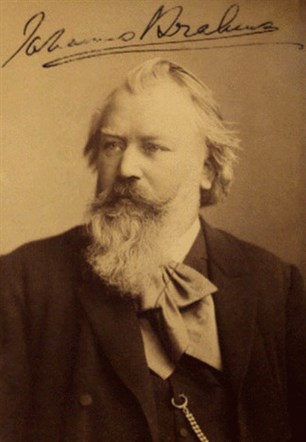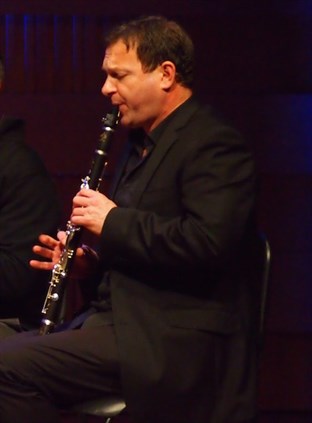Sydney Mozart Society
Affiliated with the Mozarteum, Salzburg
Sydney Mozart Society brings you Mozart and much more from the 'Golden Age' of Chamber music.

Spotlight on the Brahms Clarinet Quintet
At our next concert on 27 April 2018 the Australian World Orchestra Chamber Ensemble will perform Brahms Clarinet Quintet in B minor Op 115. The facts of how Brahms came to compose the Quintet shed much light on its intelligence, emotional warmth and beauty. Read about the Quintet then come to the concert to enjoy what will undoubtedly be a superb performance, featuring clarinet virtuoso Francesco Celata.

Johannes Brahms By C. Brasch, Berlin [Public domain]
via Wikimedia Commons
There are striking parallels between the Clarinet Quintets of Brahms and Mozart which Professor Colin Lawson CBE, clarinettist and author of a 1998 book devoted to the Brahms op.115 Quintet describes as “unquestionably the two greatest works for the medium”. Mozart’s collaboration with Stadler inspired him to compose his Clarinet Quintet and Concerto as well as a number of smaller pieces. Brahms met the Meiningen clarinettist Richard Mühlfeld in 1891 and his performance of the Mozart Clarinet Quintet was a major inspiration for Brahms abandoning his planned retirement to compose his Clarinet Trio, the Quintet and in 1894 the two Sonatas Op. 120.
From his early works, Brahms drew on his 19th century predecessors: Beethoven, Schubert, Mendelssohn and Schumann in utilising in his orchestral works combinations of the clarinet with other woodwind instruments or strings to achieve warmth or contrast. In Brahms’s own works, the opening clarinet melody of the third movement of his First Symphony is clearly a precursor to the Andantino of the Clarinet Quintet.
Brahms composed the Clarinet Quintet at the end of a lifetime of experience writing for strings, which gained special inspiration from his friendship with Joseph Joachim. The String Quintet op. 111, was intended by Brahms aged 57 at the end of 1890 to be his swansong. The advanced style and character of this work, with its return to his earlier preoccupations with the gypsy manner, has much in common with the Clarinet Quintet. The Joachim Quartet with Mühlfeld performed the work in Berlin soon after its composition and subsequently arranged performances in London.
Brahms’s Clarinet Quintet was immediately recognised as a great work, in spite of his own initial preference for the Trio. Grove’s Dictionary asserts that: “for emotional intensity and beauty of tone-colour the Clarinet Quintet may well claim the top-most place in Brahms’s chamber music”. As early as 1905, Florence May in her biography of Brahms described it as containing “the richest fruits of the golden harvest of the poet’s activity”. Clara Schumann on first hearing Mühlfeld perform the work in 1893 described it in her diary as: “a marvellous work ..…the wailing clarinet takes hold of one …… what interesting music, deep and full of meaning.”
Richard Coleman

Francesco Celata, photo: Charmain Boyakovsky
Posted on Sunday, 25 March 2018 at 10am
Society News
- 2026 Season
- Notice of AGM and Call for nominations - 2025
- 2025 Concert Season Details
- 2025 Season
- 2024 Season
- "A great concert" - and a chance to enjoy it again
- DATE CHANGE AND RENEWAL REMINDER
- Thank you, Seraphim Trio
- Thank you Flinders Quartet
- Thank you Frank Celata and Friends
- Concert details for Nov and Dec 2021
- Meet Daniel Herscovitch
- Meet Clemens Leske
- 2021 Concert Season Details
- Concerts Recommence - March and April 2021
- Cancellation of August and September concerts
- Postponement of April and May Concerts
- Meet Lloyd Van't Hoff
- Flinders Quartet, Shaping a Vibrant Music Future
- Beethoven, Out of This World
- Arts Engagement and Longevity
- A Message from the President
- Thank You Enigma Quartet
- Thank You Sophie and Kristian
- 2020 Concert Season Announcement
- Thank You Sydney Soloists
- Spotlight on Ernö Dohnányi
- Thank You Selby & Friends
- Seven Things To Know About The Seven Variations
- Thank You Goldner String Quartet
- Arthur Edward Smith, an Inspiring Life
- Thank You Australia Piano Quartet
- Music, Technology and Inclusion
- The Violins of 2018
- Thank You Streeton Trio
- Thank You Australian String Quartet
- Our New Patron - Dene Olding AM
- Thank You Australian Haydn Ensemble
- Just Announced - Our 2019 Concert Season
- Spotlight on The Australian Haydn Ensemble
- Thank You Seraphim Trio
- Seraphim Trio - Life Lessons from Music
- Spotlight on Ravel's Piano Trio in A Minor M 67
- Thank you AWO Chamber Ensemble
- There’s More to the AWO Than Performance
- Spotlight on the Brahms Clarinet Quintet
- Mozart's Irish Connection
- Thank You Flinders Quartet
- Mozart's Valentine
- Flinders Quartet Emerging Composers Project
- Thank You Enigma Quartet
- Thank You Southern Cross Soloists
- Thank You Duncan, Susan and Sue-Ellen
- The Magnificent Seven
- Spotlight on Beethoven's Septet
- Thank You Australia Piano Quartet
- The Remarkable Life of Richard Goldner
- Thank You Australian String Quartet
- A Winning Performance from the Verbrugghen Ensemble
- Meet Bridget O'Donnell
- Meet the Verbrugghen Ensemble
- Streeton Trio, What the Audience Said
- Selby and Friends, What The Audience Said
- Flinders Quartet, What the Audience Said
- Meet Zoe Knighton and the Flinders Quartet
- Seraphim Trio, What the Audience Said
- Meet Timothy Nankervis
- Thank You Selby and Friends
- Meet Helena Rathbone
- Meet Brenda Jones and the Shigeru Kawai
- Thank You Sophie and Kristian
- Meet Kristian Chong
- The Beautiful 'Cello
- Mozart and Friends, What the Audience Said
- Meet Peter Jenkin
- Sydney Soloists and Enigma Quartet, What the Audience Said
- Meet Marianne Broadfoot and the Enigma Quartet
- Goldner String Quartet, What the Audience Said
- Meet the Goldner String Quartet
- Southern Cross Soloists, What the Audience Said
- Meet Tania Frazer, Southern Cross Soloists
- Streeton Trio, What the Audience Said
- Chanterelle String Quartet, What the Audience Said
- Sydney Soloists, What the Audience Said
- Meet Julie Simonds
- Australian String Quartet
- Meet Penelope Mills
- Australia Ensemble, a Rich Musical History
- Meet Irina Morozova
- Meet Francesco Celata
- Meet Selby and Friends
- Meet the Diemen Quartet
- Remembering Razumovsky